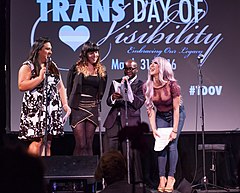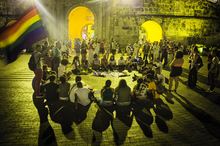The examples and perspective in this article deal primarily with the United States and do not represent a worldwide view of the subject. (March 2024) |
International Transgender Day of Visibility (often referred to as TDOV or Trans Day of Visibility) is an annual event occurring every March 31 since 2009[1][2] dedicated to celebrating transgender people and raising awareness of discrimination faced by transgender people worldwide, as well as a celebration of their contributions to society. The first International Transgender Day of Visibility was held on March 31, 2009. It has since been spearheaded by the U.S.-based youth advocacy organization Trans Student Educational Resources.[3]
| Transgender Day of Visibility | |
|---|---|
 Presenters on stage at the 2016 Trans Day of Visibility celebration in San Francisco | |
| Observed by | Transgender community and supporters |
| Type |
|
| Date | March 31 |
| Frequency | Annual |
| First time | 2009 |
| Related to | Transgender Awareness Week, Transgender Day of Remembrance |

History and milestones
edit2009 founding
editThe event was created by transgender activist[4] Rachel Crandall Crocker of Michigan in 2009[5] as a reaction to the lack of LGBTQ+ recognition of transgender people, citing the frustration that the only well-known transgender-centered day was the Transgender Day of Remembrance, which mourned the murders of transgender people, but did not acknowledge and celebrate living members of the transgender community. President Barack Obama and Vice President Biden first acknowledged this day for the transgender community; however, at that time no proclamation was signed.[citation needed]
2014
editIn 2014, the day was observed by activists across the world, including in Ireland[6] and Scotland.[7]
2015
editIn 2015, many transgender individuals participated in an online social media campaign on websites including Facebook, Twitter, Tumblr, and Instagram. Participants posted selfies, personal stories, and statistics regarding transgender issues and other related content to raise awareness and increase visibility.[8]
2021
editIn 2021, U.S. President Joe Biden proclaimed March 31 as a Transgender Day of Visibility, stating in part, "I call upon all Americans to join in the fight for full equality for all transgender people." Biden was the first American president to issue a formal presidential proclamation recognizing the event.[9][10][11] Biden issued a similar proclamation a year later, welcoming Jeopardy! contestant and transgender woman Amy Schneider to the White House and announcing a set of measures intended to support transgender rights.[12][13]
2024
edit2024 marked the 15th anniversary of Transgender Day of Visibility with celebrations planned across the globe.[14][15][16]
Reception
editOver the years, Transgender Day of Visibility has had proponents and critics.
Supporters of TDOV have organized a variety of responsive events. In 2024, for instance, AP reported on marches in Melbourne and Philadelphia, an "inclusive roller derby" on Long Island, and a picnic in a small English town. Some places have been lit up with trans flag colors, such as Niagara Falls.[17]
To advocates of TDOV, visibility enables trans people to experience less social isolation, it "illuminates and normalizes them to the rest of the world" and it builds empathy from the cisgender majority.[18] The day is seen as a way to honor elders to trans communities, according to Shelby Chestnut of the Transgender Law Center, and "visibility means having the power and the ease to show up as all of who you are at any given moment," per Tourmaline.[19]
Similarly, a trans activist originally from Belize told UNAIDS, "Visibility is power. Only when given visibility can we raise our voices and advocate for the enjoyment of our human rights." A trans interviewee from Thailand argued that TDOV could educate the public about the needs, including health care and employment.[20]
It is important to show trans people flourishing, asserted Minneapolis city councilor Andrea Jenkins, during a period of violence against those with trans identities.[21]
Effort to increase trans visibility have been criticized by Black abolitionists, who believe facile inclusion of trans persons in popular culture "leads to flattened understandings of Black trans life" and may endanger Black trans people. As abolitionist Miss Major Griffin-Gracy stated in 2019, "I don't really understand why we need a day of visibility, when for most of us, especially us Black girls, we are as visible as we need to be. Our visibility is getting us killed."[22]
Similarly, some scholars argue that over-exposure of trans people can result in erasure, by virtue of perpetuating stereotypes or reducing people to statistical measures.[22] Besides the paradox of visibility as a physical risk, others question whether TDOV is offering a "sanitized image of transgender people" that reinstantiates socioeconomic and racial exclusions.[23]
In 2024, TDOV coincided with the Christian holiday of Easter that year. U.S. President Biden's support of TDOV was condemned by some Christian Republicans, which caused a brief political "controversy, which has galvanized conservatives and which transgender advocates say is manufactured."[24] [25][26]
References
edit- ^ "Nenshi proclaims Trans Day of Visibility". Canadian Broadcasting Corporation. Archived from the original on April 4, 2013. Retrieved April 4, 2013.
- ^ "Today is International Transgender Day of Visibility". Human Rights Campaign. March 31, 2014. Archived from the original on September 11, 2018. Retrieved January 18, 2016.
- ^ "On Trans Day of Visibility, Activists Rally to Turn Compassion Into Action". TakePart. Archived from the original on December 2, 2019. Retrieved April 2, 2021.
- ^ "A time to celebrate". The Hamilton Spectator. March 27, 2014. Archived from the original on April 3, 2014. Retrieved March 31, 2014.
- ^ Carreras, Jessica (March 26, 2009). "Transgender Day of Visibility plans erupt locally, nationwide". PrideSource. Archived from the original on March 27, 2013. Retrieved April 3, 2013.
- ^ "Trans* Education & Advocacy Protest RTE March 31st". Gaelick. March 31, 2014. Archived from the original on April 3, 2014. Retrieved March 31, 2014.
- ^ "Twitter / The_SSP_: The SSP stands in solidarity ..." March 31, 2014. Archived from the original on March 4, 2016. Retrieved March 31, 2014.
- ^ "These Trans People Are Taking Selfies To Celebrate Transgender Day Of Visibility". BuzzFeed LGBT. March 31, 2015. Archived from the original on November 15, 2015. Retrieved January 18, 2016.
- ^ Jackson, Jon (March 31, 2021). "Biden is the first president to issue Transgender Day of Visibility proclamation". Newsweek. Archived from the original on February 13, 2023.
- ^ "A Proclamation on Transgender Day Of Visibility, 2021". The White House. March 31, 2021. Archived from the original on March 31, 2021. Retrieved April 2, 2021.
- ^ "Hollywood luminaries sign letter supporting trans women on Trans Day of Visibility". Los Angeles Times. March 31, 2021. Archived from the original on March 31, 2021. Retrieved April 2, 2021.
- ^ "A Proclamation on Transgender Day Of Visibility, 2022". The White House. March 30, 2022. Archived from the original on April 3, 2022. Retrieved April 12, 2022.
- ^ Judd, Donald; LeBlanc, Paul (March 31, 2022). "White House hosts 'Jeopardy!' star Amy Schneider to mark Transgender Day of Visibility". CNN. Archived from the original on April 12, 2022. Retrieved April 12, 2022.
- ^ "Trans Day of Visibility began 15 years ago. The founder is still moved by its success". NPR. March 30, 2024. Archived from the original on March 31, 2024. Retrieved March 30, 2024.
- ^ Joe Biden (March 29, 2024). "A Proclamation on Transgender Day of Visibility, 2024". The White House. Archived from the original on March 30, 2024. Retrieved March 30, 2024.
- ^ "What to know about Day of Visibility, designed to show the world 'trans joy'". Associated Press. March 28, 2024. Archived from the original on March 29, 2024. Retrieved March 30, 2024.
- ^ Mulvihill, Geoff (March 29, 2024). "What to know about Day of Visibility, designed to show the world 'trans joy'". AP News. Retrieved April 1, 2024.
- ^ Riley, Drew (March 30, 2016). "Wall of Words: Artist Drew Riley on the power of Transgender Day of Visibility". Austin Chronicle. Retrieved April 1, 2024.
- ^ "Stories: Transgender Day of Visibility". Ford Foundation. March 31, 2023. Retrieved April 1, 2024.
- ^ "Voices of activists for transgender rights". UNAIDS. March 28, 2018. Retrieved April 2, 2024.
- ^ Sosin, Kate (March 31, 2021). "The History Behind International Transgender Day of Visibility". Ms. Magazine.
- ^ Jump up to: a b Janak, Jaden (2022). "(Trans) gendering Abolition: Black Trans Geographies, Art, and the Problem of Visibility". GLQ. 28 (2): 259. doi:10.1215/10642684-9608175.
- ^ Redburn, Kate (2022). "The Visibility Trap". University of Chicago Law Review. 89 (6): 1546–7.
- ^ "Sunday marks both Easter and the Transgender Day of Visibility. Cue the culture war". Politico. March 30, 2024. Retrieved April 2, 2024.
- ^ "The Trump camp and the White House clash over Biden's recognition of 'Transgender Day of Visibility'". AP News. March 30, 2024. Retrieved March 31, 2024.
- ^ Waldenberg, Samantha (March 30, 2024). "Republicans slam Biden for proclaiming Transgender Day of Visibility on Easter, though it's yearly observed on March 31 | CNN Politics". CNN. Retrieved March 31, 2024.
External links
edit- Transgender Day of Visibility on the GLAAD website
- Transgender Day of Visibility on the GLSEN website
- International Transgender Day of Visibility // The SAGE Encyclopedia of Trans Studies, p. 443—447